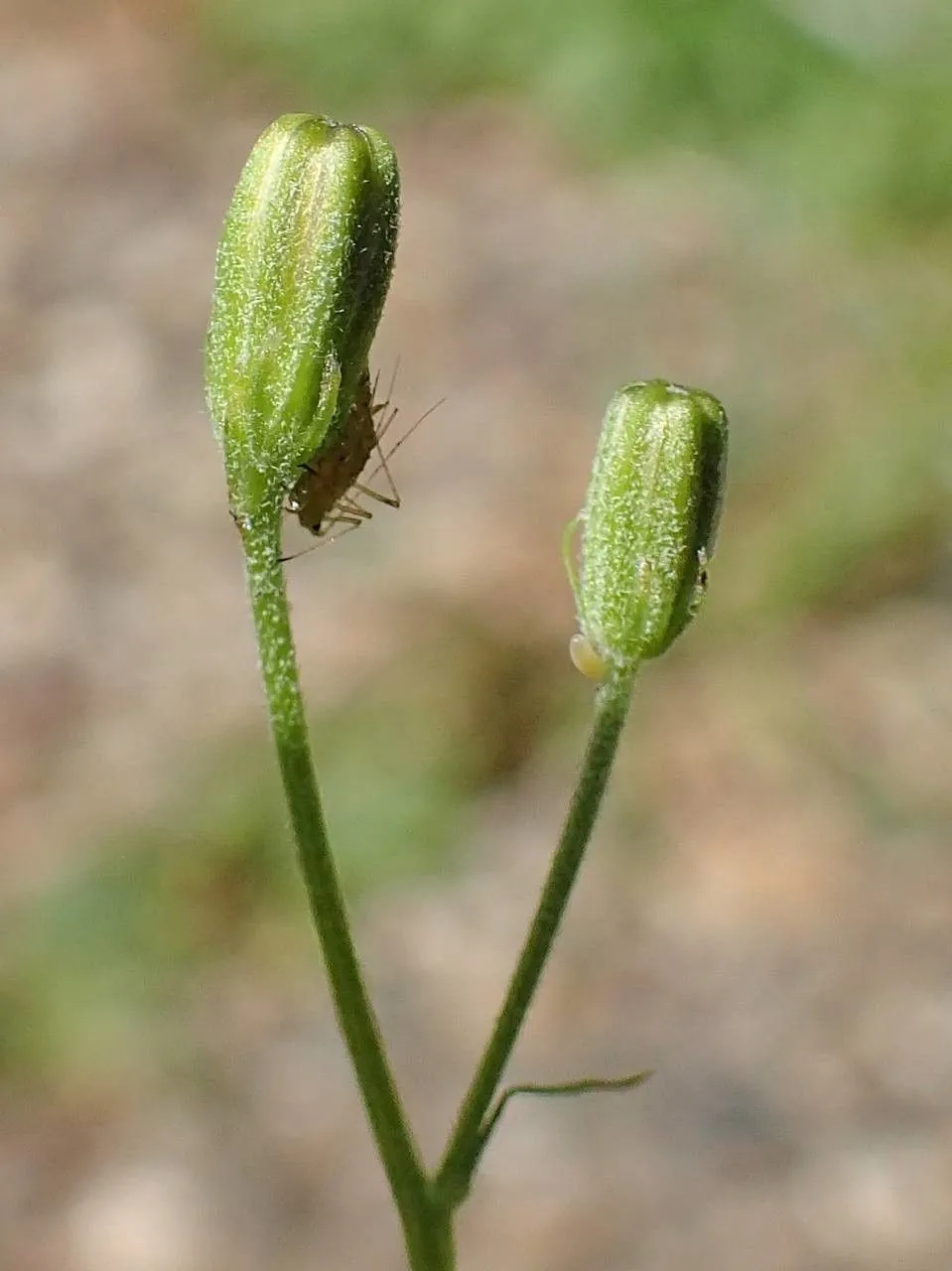
Author: (L.) Wallr.
Bibliography: Erst. Beitr. Fl. Hercyn.: 287 (1840)
Year: 1840
Status: accepted
Rank: species
Genus: Crepis
Vegetable: False
Observations: Europe to Caucasus
The Green crepis, scientifically recognized as Crepis capillaris, is a fascinating species within the Asteraceae family. This plant holds notable significance due to its widespread distribution and distinctive attributes that make it a notable member of its botanical family.
Crepis capillaris was first formally described in an important botanical compendium in 1840, as cited in the “Erst. Beitr. Fl. Hercyn.” with the contribution of the author (L.) Wallr. This historical documentation highlights the enduring recognition and study of this species over the years.
Native to a broad expanse from Europe stretching into the Caucasus, Green crepis has adapted to a variety of climates and geographical conditions. This extensive range is a testament to its resilience and adaptability, thriving in diverse environments from temperate regions to the edges of continental climates.
The botanical characteristics of Crepis capillaris are as remarkable as its geographical spread. As a member of the Asteraceae family, it shares familial traits with some of the world’s most widespread and ecologically significant plants. The inflorescences are composed of numerous small flowers grouped together, a common feature in the daisy family, which aids in attracting a wide array of pollinators.
Green crepis is often observed in habitats ranging from grasslands and meadows to roadsides and disturbed areas. This adaptability also underscores its ecological role in various landscapes, contributing to the biodiversity and functioning of the ecosystems it inhabits.
In conclusion, Crepis capillaris stands out not only for its botanical interest but also for its ecological versatility. This plant’s historical documentation and widespread presence across Eurasia highlight its significance and serve as a basis for further botanical studies and environmental appreciation.
Nor: ballastsev, brakkhaukeskjegg, heisev, ryllsev
Swe: borsttåg, grönfibbla, svärdtåg, syltåg, vanlig ryltåg
Dan: børste-siv, glanskapslet siv, grøn høgeskæg, tue-siv
Spa: chicoria loquilla
Fra: crépide capillaire, crépide verdâtre, crépide à tiges capillaires, crépis capillaire, crépis verdâtre, crépis à tige capillaire, crépis à tiges capillaires, crépide à tige capillaire
Eng: green crepis, hawksbeard, smooth hawk’s-beard, smooth hawksbeard
Fin: harjasvihvilä, hoikkakeltto, miekkavihvilä, nurmivihvilä, solmuvihvilä
Deu: kleinköpfiger pippau
Pol: pępawa zielona
Ita: radicchiella capillare
Sqi: shmangë kapilare
Nld: klein streepzaad
Ces: škarda vláskovitá
Bul: голостъблена дрипавка
Cym: gwalchlys llyfn
En: Green crepis, Smooth hawk’s-beard, Smooth hawksbeard, Hawksbeard
Sq: Shmangë kapilare
Be: Зубнік валасападобны
Bg: Голостъблена дрипавка
Ca: Crepis capil·lar
Kw: Barv an hok
Cs: Škarda vláskovitá
Da: Grøn Høgeskæg, Børste-Siv, Glanskapslet Siv, Tue-Siv
Nl: Klein streepzaad
Fi: Hoikkakeltto, Harjasvihvilä, Miekkavihvilä, Nurmivihvilä, Solmuvihvilä
Fr: Crépis capillaire, Crépide capillaire, Crépis à tiges capillaires, Crépis à tige capillaire, Crépide verdâtre, Crépide à tiges capillaires, Crépis verdâtre, Crépide à tige capillaire
De: Grüner Pippau, Kleinblütiger Pippau, Kleinköpfiger Pippau
Ga: Lus cúráin mín
It: Radicchiella capillare
No: Ballastsev, Brakkhaukeskjegg, Heisev, Ryllsev
Pl: Pępawa zielona
Sk: Škadra vláskovitá
Es: Achicoria loquilla, Chicoria loquilla
Sv: Grönfibbla, Borsttåg, Svärdtåg, Syltåg, Vanlig ryltåg
Uk: Скереда волосовидна
Cy: Gwalchlys, Gwalchlys Llyfn
Taken Jul 23, 2018 by Wolfgang Jauch (cc-by-sa)
Taken Jul 27, 2019 by Patrice SIROT (cc-by-sa)
Taken Sep 26, 2021 by Frédéric Faure (cc-by-sa)
Taken Jul 12, 2018 by gianni (cc-by-sa)
Taken Sep 7, 2017 by Heinz Gass (cc-by-sa)
Taken Jul 2, 2015 by Tela Botanica − Arthur ENGUEHARD (cc-by-sa)
Taken May 23, 2020 by Florent (cc-by-sa)
Taken Jul 7, 2021 by Yannik Hecher (cc-by-sa)
Taken Nov 24, 2021 by Panthère Rose (cc-by-sa)
Taken Jul 31, 2017 by Dieter Albrecht (cc-by-sa)
Taken Sep 10, 2016 by Tela Botanica − Yoan MARTIN (cc-by-sa)
Taken Jul 6, 2021 by Ernst Fürst (cc-by-sa)
Taken Jun 4, 2022 by Kai Best (cc-by-sa)
Taken Jun 28, 2020 by Sabina Hartmann (cc-by-sa)
Taken May 23, 2020 by Florent (cc-by-sa)
Taken Nov 1, 2014 by Tela Botanica − Quentin LEBASTARD (cc-by-sa)
Taken Jun 22, 2014 by Tela Botanica − Françoise CARLE (cc-by-sa)
Taken Jun 27, 2014 by Tela Botanica − Jean-Luc Gorremans (cc-by-sa)
Taken Sep 14, 2014 by Tela Botanica − Henri SCORDIA (cc-by-sa)
Taken Jun 22, 2014 by Tela Botanica − Françoise CARLE (cc-by-sa)
Taken Jul 25, 2021 by Vroklage Bart (cc-by-sa)
Taken May 28, 2011 by Tela Botanica − Bertrand BUI (cc-by-sa)
Taken Sep 10, 2016 by Tela Botanica − Yoan MARTIN (cc-by-sa)
Taken Aug 29, 2015 by Tela Botanica − Henri SCORDIA (cc-by-sa)
Taken Apr 8, 2019 by Renaud Brochiero (cc-by-sa)
Taken Jan 1, 1800 by Tela Botanica − Thierry Pernot (cc-by-sa)
Taken Sep 30, 2019 by Gian-Luca Borra (cc-by-sa)
Taken Jul 13, 2014 by Tela Botanica − Florent Beck (cc-by-sa)
Taken May 28, 2011 by Tela Botanica − Bertrand BUI (cc-by-sa)
Taken Aug 2, 2021 by Syl Fred (cc-by-sa)
© copyright of the Board of Trustees of the Royal Botanic Gardens, Kew.
© copyright of the Board of Trustees of the Royal Botanic Gardens, Kew.
© copyright of the Board of Trustees of the Royal Botanic Gardens, Kew.
Family: Myrtaceae Author: (F.Muell.) K.D.Hill & L.A.S.Johnson Bibliography: Telopea 6: 402 (1995) Year: 1995 Status:…
Family: Rubiaceae Author: Pierre ex A.Froehner Bibliography: Notizbl. Bot. Gart. Berlin-Dahlem 1: 237 (1897) Year:…
Family: Sapindaceae Author: Koidz. Bibliography: J. Coll. Sci. Imp. Univ. Tokyo 32(1): 38 (1911) Year:…
Family: Asteraceae Author: A.Gray Bibliography: Pacif. Railr. Rep.: 107 (1857) Year: 1857 Status: accepted Rank:…
Family: Fabaceae Author: Medik. Bibliography: Vorles. Churpfälz. Phys.-Ökon. Ges. 2: 398 (1787) Year: 1787 Status:…
Family: Aspleniaceae Author: (Cav.) Alston Bibliography: Bull. Misc. Inform. Kew 1932: 309 (1932) Year: 1932…